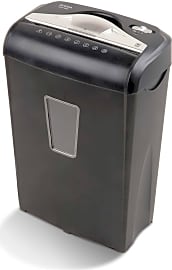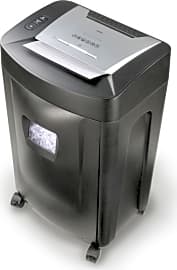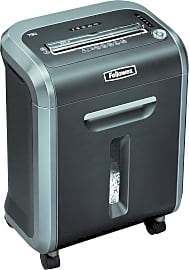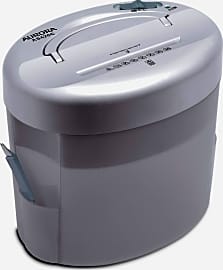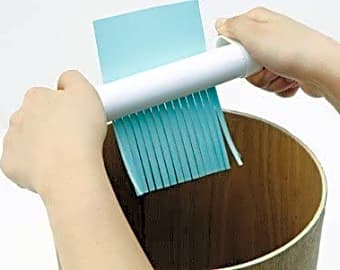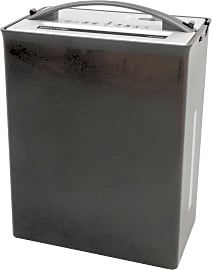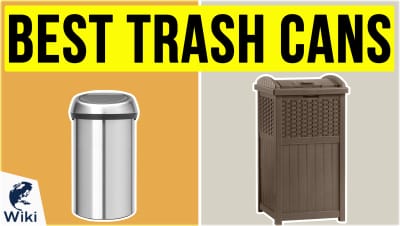The 10 Best Paper Shredders

This wiki has been updated 43 times since it was first published in May of 2015. Protect yourself from identity theft at home and corporate espionage at the office with one of these paper and credit card shredders, which can turn your sensitive documents into confetti in no time. Our selection includes models at a variety of price points suitable for everything from occasional junk mail destruction to heavy-duty use. Just be sure to keep kids and pets away from the paper slot. When users buy our independently chosen editorial selections, we may earn commissions to help fund the Wiki.
Editor's Notes
December 16, 2020:
With this update, we've largely focused on cross-cut and micro-cut models, most rated to P-4 standards, which is more than adequate for providing most at-home and business security. When it comes to these models, the AmazonBasics 24-Sheet remains in the top spot. We like its casters, user-friendly operation, and the fact that this model comes in other versions for those who don't need the 24-sheet capacity.
The Aurora High-Security and the Fellowes Powershred 125Ci remain, as well, with the former giving excellent peace of mind for the price, and the latter offering power and jam prevention you can count on. For a less expensive version of the Fellowes machine, we kept the Fellowes 79Ci. It doesn't have as many bells and whistles, but it's quiet, reliable, and energy saving.
If it's affordability on which you're focused, take a look at the newly added Bonsaii 6-Sheet. While it's true that some of their machines can't live up to the top competitors when it comes to long-term durability, this small machine is a good choice for occasional use, especially if you don't want to spring for one of the pricier models.
As for other types, we added the tiny Muji Handy for those who need portability and simplicity. It's operated by hand, so no electricity is required, but it produces strip cuts, so don't rely on it to protect ultra-sensitive information. You'll also need to supply your own trash can, perhaps one that's hands-free, as it doesn't have a bin for paper collection. At the other end of the security spectrum, the Dahle PowerTEC 727 CS joins the list as a Special Honor. Rated to P-7 standards, it will nearly obliterate paper, but the extremely high price ensures that it's overkill for many uses.
December 18, 2019:
Because of potential issues with its overall durability, we have opted to remove the Bonsaii C149 at this time. We've elected to remove the AmazonBasics 12-Sheet, as well, due to occasional issues with availability. But both the AmazonBasics 24-Sheet and the AmazonBasics 6-Sheet make fine options. The former is built a little more robustly, since it is designed to handle more sheets at once. Plus, it has plenty of usability features, including some found on more expensive models like the Fellowes 79Ci. We've also opted to add the Aurora High-Security as a budget choice. It creates micro-cut pieces and is easy to empty into a trash can, something that can't be said of all models. And for those who are in a hurry, we've kept the Fellowes Powershred 125Ci. The large bin and continuous shredding ensure that you can quickly tackle stacks of sensitive documents and carry on with your day.
Special Honors
GBC Stack-and-Shred 600M For a home office, the GBC Stack-and-Shred 600M is probably overkill. But for offices that have the budget for the four-digit price, and that need the 600-sheet capacity, it may be just the ticket. It stands around three feet tall, so expect it to take up some space. gbc.com
Ameri-Shred Series 3 Cross Cut The Ameri-Shred Series 3 Cross Cut is a robust industrial model that can handle up to 2,600 pounds of paper in an hour. You can count on the all-steel construction to go the distance, while the extra-large feed table makes for a smooth operation. ameri-shred.com
Dahle PowerTEC 727 CS When they say that the Dahle PowerTEC 727 CS can handle top-secret documents, they aren't kidding, as this is a P-7 model that's NSA approved. It has an automatic, self-lubricating feature that ensures it is easy to use in the long run, as well as jam protection capabilities that take the hassle out of shredding. dahle.com
How To Choose The Best Shredder
And on top of that, users must make decisions about what capacity and speed is sufficient, as well as how much continuous run time is adequate.
Finding a reliable shredder can be tough. Unlike some product categories, the quality of a shredder can vary significantly between products both in terms of how it shreds documents and how well it handles jams or overheating. And on top of that, users must make decisions about what capacity and speed is sufficient, as well as how much continuous run time is adequate. To help you discern what shredder is best for your individual needs, we've written a guide to choosing the best shredder.
Shredders should ideally serve to increase entropy—which is to say, randomness—by decreasing the size of the shredded particles. Thinking about this practically means that the more, smaller pieces there are, the more difficult it will be to reconstruct the document. For this reason, shredders are foremost classified by the sizes and shapes of the shredded particles they produce. Within each type are shredders whose designs range from small, personal use to large, commercial or industrial use.
Strip-cut shredders feature rotating blades that simply cut sheets into strips. This type of shredder creates the fewest pieces, thus creating less entropy, while also generating waste that takes up the most space. For this reason, strip-cut shredders are the least secure, however, they are often used for recycling or to create animal bedding.
Cross-cut shredders (also called confetti-cut) feature two counter-rotating shafts whose blades interlock. Depending on the shredder, they can create either rectangular, diamond, or parallelogram-shaped pieces. Particle-cut shredders are similar to cross-cut paper shredders, however, they create even smaller pieces. Usually, their shredded pieces are square or circular, but this can vary.
Pierce and tear shredders use two counter-rotating shafts covered with small circular blades and hooks. The hooks pierce the document and drag it through to the opposite blade, where it tears between two opposing forces.
Hammermills use hammers on rotating drums to force material through a screen and create particles of a given size. These are often used in more industrial contexts.
Disintegrator shredders (or granulators) randomly cut paper continuously until the particles are small enough to progress through a mesh or screen of a given size. This type of shredder is usually considered to meet very high security standards.
Shredders are also classified by security standards, called the DIN Standard, now known as DIN 66399. The DIN outlines six data media categories, each of which contains seven security levels. The categories are P (information in original size, such as paper), O (optical digital media), T (magnetic data media), E (electronic data media), F (information in reduced form), and H (hard drives with magnetic data media).
Fun DIY Uses For All Your Shredded Paper
What to do with all your shredded paper? Besides recycling, there are plenty of fun ways to make use of this unusual craft medium.
Besides recycling, there are plenty of fun ways to make use of this unusual craft medium.
Paper is made of cellulose, a compound that naturally appears in plants. For this reason, shredded paper makes excellent compost. If you add too much paper, which contains high amounts of carbon, you could throw off the carbon-to-nitrogen ratio, but you'd have to add a lot of paper for this to happen. And, if it does, you can restore the balance by adding some nitrogenous manure or grass materials to your compost.
With the addition of egg cartons and wax, shredded paper can be used to make excellent fire starters! These are far more economical than store-bought fire starters and supremely easy to make.
Papier-mâché literally means "chewed paper" in French; shredded paper becomes a sculptural medium for the artistic among us. Just add glue, a liquid starch mixture, or other adhesive to begin forming your art. Try layering the mixture on a balloon or wire form.
Because shredded paper is light and takes up a lot of space, it makes excellent packing material. Use it in place of tissue paper in gift bags, or as padding in mailed packages. It can also be used to pack breakables, such as ornaments.
The Origins Of The Paper Shredder
The invention of the paper shredder is often credited to a German man named Adolf Ehinger, who manufactured a paper shredder in 1935, but this credit is slightly misplaced. The first paper shredder was actually patented several years prior, in 1909, by the American inventor Abbott Augustus Low.
Low's patent detailed a "waste paper receptacle" with rolling blades connected to a paper feeder. Although Low's invention was never manufactured, his design was quite advanced for its time. In his patent, Low explains that his design included "means for stopping the device automatically," as well as "a device for compressing and packing the disintegrated paper within the receptacle."
People thought his invention was useless, failing to understand why it would later become one of the most useful inventions of the 20th century.
Similar to the reasons we use paper shredders today, Low intended for his shredder design to be used in "offices, banks, counting houses, and, under conditions, where the practical destruction of correspondence, memoranda, liquidated bonds, accounts, books, and the like is a desideratum..." Unfortunately, Low's paper shredder patent seemed to have been forgotten about, and paper shredder innovation was dormant until 1935.
Adolf Ehinger was an ordinary man who worked on tools and small machines during the Third Reich in Balingen, Germany. He had a secret, though: he was a quiet dissident of Nazi Germany, holding anti-Nazi political views. According to legend, Ehinger created anti-Nazi propaganda at home, some of which was spotted in a trash can by a neighbor.
Upon finding this material, the neighbor threatened to turn Ehinger into the authorities. In fear, Ehinger set out to invent the first paper shredder. How he invented the shredder in time to thwart the authorities is unclear, as is why his first instinct was to invent a small machine rather than dispose of his papers elsewhere. Nevertheless, the paper shredder was born.
Inspired by the hand-crank pasta maker frequently used in traditional German pasta and spaetzle, which divided pasta dough into strips, Ehinger devised the first hand-cranked paper shredder. He widened the opening to accommodate the width of sheets of paper, and housed it in a wooden frame.
Eventually, he added an electric motor, and patented the device in 1936. Upon taking the shredder to a trade show, however, Ehinger was laughed at by those in attendance. People thought his invention was useless, failing to understand why it would later become one of the most useful inventions of the 20th century.


